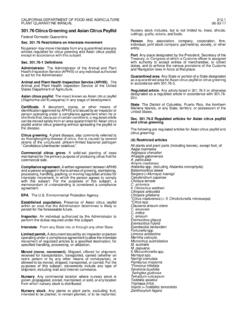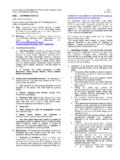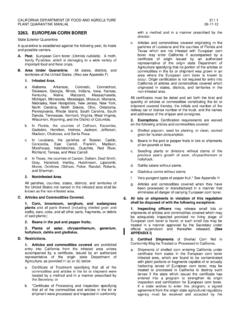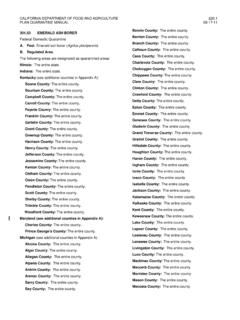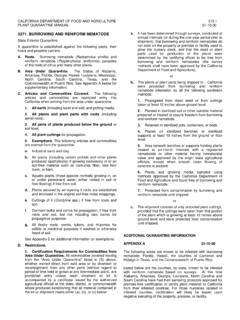Transcription of CALFORNIA DEPARTMENT OF FOOD AND AGRICULTURE …
1 CALFORNIA DEPARTMENT OF FOOD AND AGRICULTURE PLANT QUARANTINE MANUAL 12-28-17 3435. asian citrus psyllid State Interior Quarantine A. Pest. A quarantine is established against the following pest, its hosts, and possible carriers: (a) asian citrus psyllid (Diaphorina citri). B. Regional Quarantine Zones: (1) A county or portion thereof shall be included in an appropriate host nursery stock regional quarantine zone and bulk citrus regional quarantine zone when survey results indicate an infestation is present or not, and the DEPARTMENT has evaluated the county based on the pest risk factors in Subsection (b)(2), or the local California County Agricultural Commissioner(s) is notified and requests the county be included into a regional quarantine zone. The DEPARTMENT shall also issue electronic and/or written notification of the regional quarantine zone designation(s) to other California County Agricultural Commissioners and other interested or affected parties and post notification of the designation to its website at: The notification shall include a web link to a map of the host nursery stock regional quarantine zones and bulk citrus regional quarantine zones, a list of the counties or portions thereof in each regional quarantine zone, a written description of the DEPARTMENT s evaluation of the pest risk factors associated with the county or portion thereof, and instructions on the process to appeal the designation of a county or portion thereof into a regional quarantine zone.
2 Automatic notifications of any changes in regional quarantine zone designations will be available through a list serve option. Any individual or local entity may appeal the designation of a county or portion thereof into a regional quarantine zone by submission to the DEPARTMENT of a written request for review of the designation accompanied by clear and convincing evidence justifying a change in the designation. The appeal must be filed no later than ten (10) working days following issuance of the notice of designation by the DEPARTMENT . The DEPARTMENT must respond with a written decision no later than ten (10) working days following receipt of the appeal. During the pending of the appeal, the designation under appeal shall remain in effect. (2) A county or a portion thereof shall be included in a regional quarantine zone based upon a combination of the following pest risk factors: (A) The level of asian citrus psyllid infestation 1.
3 Generally Infested Regions are counties or parts of counties where multiple asian citrus psyllids are routinely detected throughout the area and during every survey period. 2. Partially Infested Regions are counties or parts of counties where asian citrus psyllids have been detected, but are not routinely detected throughout the area or during every survey period 3. Uninfested Regions are counties or parts of counties where asian citrus psyllids have not been detected (B) The presence of or proximity to Huanglongbing disease detections (C) The proximity to the United States/Mexico border (D) Geographical barriers to the natural movement of ACP, such as mountains or host-free areas (E) Contains a commercial citrus growing region (F) Whether sufficient citrus commodity cleaning and packing capacity is available to process the majority of citrus grown in a region, as determined by the DEPARTMENT in consultation with citrus industry experts knowledgeable in citrus variety, acreage increase or decrease trends, historical production volumes for different regions, and volume capability of cleaning and packing capacity in different regions.
4 (3) The following Host Nursery Stock Regional Quarantine zones and Bulk citrus Regional Quarantine zones will be designated to restrict movement of asian citrus psyllid host material. Nursery Stock Regional Quarantine Zone 1 comprises uninfested counties, geographical barriers exist between it and Zone 3, and it is not proximate to the border with Mexico. Nursery Stock Regional Quarantine Zone 2 comprises counties that are partially infested with ACP, CALFORNIA DEPARTMENT OF FOOD AND AGRICULTURE PLANT QUARANTINE MANUAL 12-28-17 geographical barriers exist between it and Zone 3, HLB has not been detected, and the zone is not proximate to the border with Mexico. Nursery Stock Regional Quarantine Zone 3 comprises counties that are generally infested with ACP, HLB has been detected in some areas, and the zone is proximate to the border with Mexico. Bulk citrus Regional Quarantine Zone 1 comprises uninfested counties where HLB has not been detected, there are no contiguous citrus growing regions, and it is not proximate to the border with Mexico.
5 Bulk citrus Regional Quarantine Zone 2 comprises counties that are partially infested with ACP, HLB has not been detected, a geographical barrier exists between it and adjacent citrus growing regions ( , Zones 4, 5, and 6), a citrus growing region exists within the zone, sufficient citrus commodity cleaning and packing capacity exists within the zone, and geographical barriers separate it from zones that are generally infested with ACP and where HLB has been detected ( , Zone 6). Bulk citrus Regional Quarantine Zone 3 comprises counties that are partially infested with ACP, HLB has not been detected, a geographical barrier exists between it and adjacent citrus growing regions ( , Zones 2 and 4), a citrus growing region exists within the zone, sufficient citrus commodity cleaning and packing capacity exists within the zone, and geographical barriers separate it from zones that are generally infested with ACP ( , Zone 4) or where HLB has been detected ( , Zone 6).
6 Bulk citrus Regional Quarantine Zone 4 comprises counties that are generally infested with ACP, HLB has not been detected, a geographical barrier exists between it and adjacent citrus growing regions ( , Zones 2 and 3), a citrus growing region exists within the zone, sufficient citrus commodity cleaning and packing capacity exists within the zone, geographical barriers separate it from Zone 6 where HLB has been detected, and it is not proximate to the border with Mexico. Bulk citrus Regional Quarantine Zone 5 comprises counties that are generally infested with ACP, HLB has not been detected, a geographical barrier exists between it and adjacent citrus growing regions ( , Zones 4 and 6), a citrus growing region exists within the zone, sufficient citrus commodity cleaning and packing capacity exists within the zone, a geographical barrier separates it from Zone 6 where HLB has been detected, and it is proximate to the border with Mexico.
7 Bulk citrus Regional Quarantine Zone 6 comprises counties, or portions of counties, that are generally infested with ACP, HLB has been detected in some areas, a geographical barrier exists between it and adjacent citrus growing regions ( , Zones 2, 4, and 5), a citrus growing region exists within the zone, sufficient citrus commodity cleaning and packing capacity exists within the zone, and it is not proximate to the border with Mexico. Bulk citrus Regional Quarantine Zone 7 comprises counties that are partially infested with ACP, HLB has not been detected, there are no contiguous citrus growing regions, and it is not proximate to the border with Mexico. C. Articles and Commodities Covered. The following are declared to be hosts and possible carriers of Diaphorina citri. (1 ) All nursery stock, plants, plant parts, including green waste, and plant products capable of propagation, except seed extracted from fruit of: Aegle marmelos (bael, Bengal quince, golden apple, bela, milva) Aeglopsis chevalieri (Chevalier's aeglopsis) Afraegle gabonensis (Gabon powder-flask) Afraegle paniculata (Nigerian powder-flask) Amyris madrensis (mountain torchwood) Atalantia spp.
8 Including Atalantia monophylla (Indian atalantia) Balsamocitrus dawei (Uganda powder-flask) Bergera (=Murraya) koenigii (curry leaf) Calodendrum capense (Cape chestnut) Choisya arizonica (Arizonia orange) Choisya ternata (Mexican or mock orange) CALFORNIA DEPARTMENT OF FOOD AND AGRICULTURE PLANT QUARANTINE MANUAL 12-28-17 X Citroncirus webberi Citropsis articulata (Katimboro, Muboro, West African cherry orange) Citropsis gilletiana (cherry-orange) citrus aurantiifolia (lime, Key lime, Persian lime, lima, lim n agrio, lim n ceut , lima mejicana, limero) citrus aurantium (sour orange, Seville orange, bigarde, marmalade orange, naranja agria, naranja amarga) citrus hystrix (Mauritius papeda, Kaffir lime) citrus jambhiri (rough lemon, jambhiri-orange, lim n rugoso, rugoso) citrus limon (lemon, lim n, limonero) citrus madurensis (=X Citrofortunella microcarpa) citrus maxima (pummelo, pomelo, shaddock, pompelmous, toronja) citrus medica (citron, cidra, cidro, toronja) citrus meyeri (Meyer lemon, dwarf lemon) citrus nobilis (king mandarin, tangor, Florida orange, King-of-Siam) citrus paradisi (grapefruit, pomelo, toronja) citrus reticulata (mandarin, tangerine, mandarina) citrus sinensis (sweet orange, orange, naranja, naranja dulce) citrus spp.
9 Clausena anisum-olens (anis) Clausena excavata (clausena) Clausena indica (clausena) Clausena lansium (wampi, wampee) Eremocitrus glauca (Australian desert lime) Eremocitrus hybrid Esenbeckia berlandieri Fortunella crassifolia (Meiwa kumquat) Fortunella margarita (Nagami kumquat, oval kumquat) Fortunella polyandra (Malayan kumquat) Fortunella spp. Limonia acidissima (Indian wood apple) Merrillia caloxylon (flowering merrillia) Microcitrus australasica (finger-lime) Microcitrus australis (Australian round-lime) Microcitrus papuana (desert-lime) X Microcitronella spp. Murraya spp. (curry leaf, orange-jasmine, Chinese-box, naranjo jazm n) Naringi crenulata (naringi) Pamburus (= Atalantia) missionis (pamburus) Poncirus trifoliata (trifoliate orange, naranjo tr bol) Severinia buxifolia (Chinese box-orange) Swinglea glutinosa (tabog) Tetradium ruticarpum (evodia, wu zhu yu) Toddalia asiatica (orange climber) CALFORNIA DEPARTMENT OF FOOD AND AGRICULTURE PLANT QUARANTINE MANUAL 12-28-17 Triphasia trifolia (trifoliate limeberry, triphasia) Vepris (=Toddalia) lanceolata (white ironwood) Zanthoxylum fagara (wild lime, lime prickly-ash) (2 ) Any other articles which are infested or exposed to infestation by Diaphorina citri.
10 (3 ) Possible carriers shall include all appliances used in the growing, harvesting, processing and hauling of the host plants and plant parts and any green waste residues including but not limited to tractors, trailers, trucks, planting, picking and pruning equipment and processing machinery and any other article, thing or means of conveyance when it is determined by the Secretary or county agricultural commissioner to present a hazard of spreading live life stages of the Diaphorina citri. (4 ) citrus fruit in bulk containers or bins or any citrus fruit with leaves and stems attached and associated green waste. (5 ) Exemptions. The following articles are exempt from the provisions of this subsection: (A) Defoliated dormant bare-rooted nursery stock; (B) Defoliated dormant nursery stock in containers where all leaf litter and any weeds have been removed; (C) Host fruit commercially cleaned, graded, and packed within a bulk citrus regional quarantine zone may move within or from the quarantine zone; (D) Non-commercially cleaned host fruit for personal consumption and under 25 pounds in weight may move within and from the bulk citrus regional quarantine zones if free of all stems and leaves; (E) Green waste of citrus fruit covered in subsection (c)(4) may move within a bulk citrus quarantine zone.
